The KOAT TV Red Light Case
I tried to make sense of the dismissal of the right turn on a red light notification.
The story about Gary Williams, a KOAT TV employee’s recent experience was a bit confusing.
As I understand it, Williams received a notification for making a right turn on a red light at eastbound, Montgomery where it intersects to southbound Carlisle. The notification video indicates the turn was made more than nine seconds after the light turned red.
 The video KOAT aired of the Redflex video stream, above, is blocked and the upper right hand corner where the light should be is blacked out. The overhead signal lights are green. The vehicle in question on the tape clearly did not come to a complete stop while making the right turn; it appears to have legally entered the intersection.
The video KOAT aired of the Redflex video stream, above, is blocked and the upper right hand corner where the light should be is blacked out. The overhead signal lights are green. The vehicle in question on the tape clearly did not come to a complete stop while making the right turn; it appears to have legally entered the intersection.  The KOAT TV employee went back to the intersection and video taped the signal showing the green right turn arrow on for 17 seconds while the rest of the signal was red.
The KOAT TV employee went back to the intersection and video taped the signal showing the green right turn arrow on for 17 seconds while the rest of the signal was red.Williams went to a hearing and made his presentation. During the on-camera interview he said that the quality of Redflex’s on-line video, based on its poor resolution and frame rate made it difficult to accurately ascertain what happened.
The notice was dismissed.
Albuquerque Police Public Information Officer John Walsh told KOAT TV that the city’s traffic engineers would look into the situation.
Williams did not return a phone call seeking further explanation and comment.
So what’s wrong with this picture?
I am no fan of the red light camera, but I have questions and maybe even doubts about what KOAT TV presented. The stations videotape showed the legal right turn in red/green arrow situation. However, they were unable to show an unobstructed view of the Redflex video. The Redflex images do, show that the light was red for 9.26 seconds, below.

If the obstruction on the Redflex video was caused by Redflex, or some other factor then not being able to see the violation is grounds for a dismissal. The station’s videotape adds nothing to the discussion unless the employee disputes the electronic recording of the lights condition. Otherwise, that tape was a comparison of apples and oranges.
 I went to the intersection a couple of days after KOAT aired the story to make my own observations of the situation. The incident might have occurred up to 100 days prior to the hearing. No telling how many times the camera system was maintained and calibrated during that time. Through previous testimony, given at earlier appeals, APD’s Lt. Robert Harrhughes, who manages the automated enforcement program stated that each intersection’s speed cameras are calibrated, once a month, using a laser radar and a police unit with a calibrated odometer. All three must match. At the same time, the computers that record the camera information are continually monitored. There are two things I do not argue about the automated enforcement program: the physics and the technology.
I went to the intersection a couple of days after KOAT aired the story to make my own observations of the situation. The incident might have occurred up to 100 days prior to the hearing. No telling how many times the camera system was maintained and calibrated during that time. Through previous testimony, given at earlier appeals, APD’s Lt. Robert Harrhughes, who manages the automated enforcement program stated that each intersection’s speed cameras are calibrated, once a month, using a laser radar and a police unit with a calibrated odometer. All three must match. At the same time, the computers that record the camera information are continually monitored. There are two things I do not argue about the automated enforcement program: the physics and the technology. My complaint is with the city’s leaders ignoring the fundamentals of the legal theories that they must overlook in order to adopt the automated enforcement program. Jurisdiction is the other issue I dispute.
The city cites the case of “One White Chevy,” a New Mexico Supreme Court case, which upheld the forfeiture of the vehicle used in a driving while under the influence case. That case was initially pursued as a criminal motor vehicle case, with a conviction, before the city “administratively” forfeited the car. Another case, referred to as the Rivera ruling, after Bernalillo County District Court Judge Geraldine Rivera, has been argued by the city before city council that she authorized the use of the city’s hearing officer. I funded the case for a friend who received a red light notice.
A few things are of note in Rivera’s ruling: The city attorney admitted that under the automated enforcement program, vehicles were not being and would not be subject to forfeiture, in spite of what the ordinance read. Rivera did not address the jurisdictional matter in three ways: she did not explore the discrepancy between the state law that requires all civil cases be decided in the State’s Metropolitan Court in Bernalillo County and she did not explore the state law that requires that all public nuisance abatement cases shall be adjudicated in District Court. The other problem she has is that she does not explain how the city administrative hearing officer gains administrative control over what is, by their own ordinance, a misdemeanor traffic violation, pursued as a civil matter administratively.
Rivera magically accepts that the city can create a judicial branch, even though in the early ’80s the New Mexico Supreme Court abolished the municipal court and the legislature funded the Metropolitan Court. The city has no administrative control over what is exclusively the providence of the state; the licensing and registration of motor vehicles within the state.
Williams’s assertion is correct that the quality of Redflex’s on-line video is of poor resolution and the frame rate make it difficult to accurately ascertain what happens.
Right turns on reds are very problematic, because drivers tend not to come to a full stop, especially at intersections like Montgomery and Carlisle. That particular intersection is troubling because Carlisle, extending to the north of Montgomery dead-ends and generates very little traffic southbound. Eastbound drivers have a clear sight line of Carlisle and tend to do what is referred to as a California boulevard stop, or a “rolling stop.”
 The truck, above, though it slowed, did not come to a complete stop and the embedded sensors registered that, triggering the strobes and camera.
The truck, above, though it slowed, did not come to a complete stop and the embedded sensors registered that, triggering the strobes and camera.I think KOAT TV’s story might have bamboozled me and even the hearing officer. I’m sure it has bamboozled the viewing audience.
The reporting and the selectively edited visuals are less than clear as to what the reporter and especially the anchors purported the story to be.
No comments:
Post a Comment